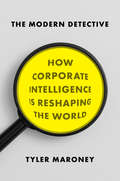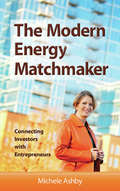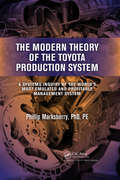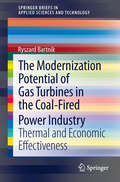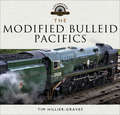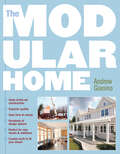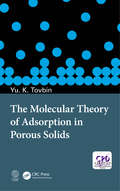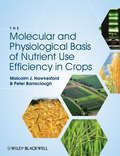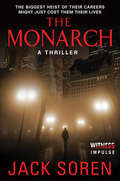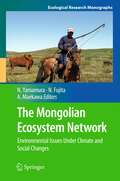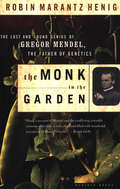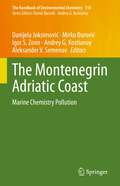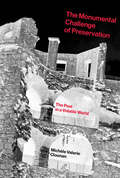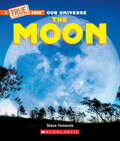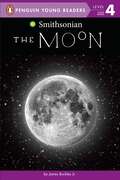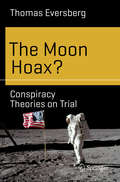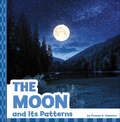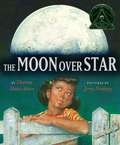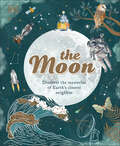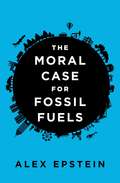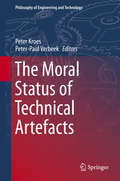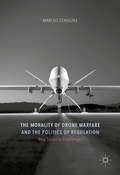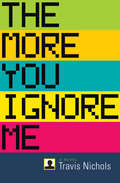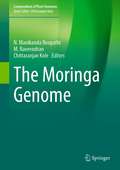- Table View
- List View
The Modern Detective: How Corporate Intelligence Is Reshaping the World
by Tyler MaroneyA fascinating examination of the world of private investigators by a 21st-century private eye.Today's world is complicated: companies are becoming more powerful than nations, the lines between public and corporate institutions grow murkier, and the internet is shredding our privacy. To combat these onslaughts, people everywhere -- rich and not so rich, in business and in their personal lives -- are turning away from traditional police, lawyers, and government regulators toward a new champion: the private investigator.As a private investigator, Tyler Maroney has traveled the globe, overseeing sensitive investigations and untying complicated cases for a wide array of clients. In his new book, he shows that it's private eyes who today are being called upon to catch corrupt politicians, track down international embezzlers, and mine reams of data to reveal which CEOs are lying. The tools Maroney and other private investigators use are a mix of the traditional and the cutting edge, from old phone records to computer forensics to solid (and often inspired) street-level investigative work. The most useful assets private investigators have, Maroney has found, are their resourcefulness and their creativity.Each of the investigations Maroney explores in this book highlights an individual case and the people involved in it, and in each account he explains how the transgressors were caught and what lessons can be learned from it. Whether the clients are a Middle Eastern billionaire whose employees stole millions from him, the director of a private equity firm wanting a background check on a potential hire (a known convicted felon), or creditors of a wealthy American investor trying to recoup their money after he fled the country to avoid bankruptcy, all of them hired private investigators to solve problems the authorities either can't or won't touch. In an era when it's both easier and more difficult than ever to disappear after a crime is committed, it's the modern detective people are turning to for help, for revenge, and for justice.
The Modern Energy Matchmaker: Connecting Investors with Entrepreneurs
by Michele AshbyExplaining the trends and key words in the green energy movement, this book examines the idea of modern energy—a combination of old and new energy resources—and the costs involved in making them operational. Resources that include wind, solar, nuclear, wave, biofuels, biomass, smart grid technologies, magnetics, hydropower, oil, gas, and coal all need to be partnered with entrepreneurs to bring them to life. Fusing intellectual and financial resources can secure a modern energy-reliant future, and this proposal directs the world's investors to begin that partnership.
The Modern Real Estate Professionals Guide to Success: Building a Sustainable and Successful Real Estate Business in Today's World
by Marki Lemons RyhalThe real estate industry is a unique industry. You can earn a real estate license, but it will not teach you how to sell real estate. No one knows how to sell real estate as the result of attending real estate school. The only people who come into the real estate industry, and who know how to sell real estate, are generally going to be second or third-generation real estate professional who grew up in the business with parents who made them go to open houses and attend showing appointments. 98 percent of people who earn a real estate license have no idea what they've just gotten themselves into, and they believe that it is their broker's responsibility to provide them with leads. They do not know that real estate is about entrepreneurship and that the majority of those with a real estate license are independent contractors. If you want to engage in real estate, you should know that you will be an independent contractor, you will be an entrepreneur, and you will be responsible for generating revenue. If you want to make a million dollars, well, you need to know how to generate leads. Agents need to know how to operate their own business, and they need to develop a business plan based on the market they want to serve. It is your responsibility as an agent to keep up with any changes to the rules and regulations in the business. It's also your responsibility to educate yourself on the latest trends in your local community and the technology you can use to reach that community. This book will help.
The Modern Theory of the Toyota Production System: A Systems Inquiry of the World's Most Emulated and Profitable Management System
by Phillip MarksberryNumerous books have been written about Toyota's approach to workplace improvement; however, most describe Toyota's practices as case studies or stories. Designed to aid in the implementation of Lean manufacturing, The Modern Theory of the Toyota Production System: A Systems Inquiry of the Worlds Most Emulated and Profitable Management System expla
The Modernization Potential of Gas Turbines in the Coal-Fired Power Industry
by Ryszard BartnikThe opportunity of repowering the existing condensing power stations by means of gas turbogenerators offers an important opportunity to considerably improvement of their energy efficiency. The Modernization Potential of Gas turbines in the Coal-Fired Power Industry presents the methodology, calculation procedures and tools used to support enterprise planning for adapting power stations to dual-fuel gas-steam combined-cycle technologies. Both the conceptual and practical aspects of the conversion of existing coal-fired power plants is covered. Discussions of the feasibility, advantages and disadvantages and possible methods are supported by chapters presenting equations of energy efficiency for the conditions of repowering a power unit by installing a gas turbogenerator in a parallel system and the results of technical calculations involving the selection heating structures of heat recovery steam generators. A methodology for analyzing thermodynamic and economic effectiveness for the selection of a structure of the heat recovery steam generator for the repowered power unit is also explained. The Modernization Potential of Gas turbines in the Coal-Fired Power Industry is an informative monograph written for researchers, postgraduate students and policy makers in power engineering.
The Modified Bulleid Pacifics (Locomotive Portfolios)
by Tim Hillier-GravesThis British Railways history recounts the life of a controversial steam engine and its miraculous transformation at the hands of a brilliant engineer. As Chief Mechanical Engineer of the Southern Railway, Oliver Bulleid designed what were perhaps the most controversial steam locomotives ever built in Britain: the Pacifics. Loved and loathed in equal measure, the debate over their strengths and weaknesses took on a new dimension when British Railways decided to modify them in the 1950s. When noted engineer Ron Jarvis was charged with improving on Bulleid&’s designs, he displayed a master&’s touch, saving the best of Bulleid&’s work while incorporating other established design principles. What emerged was described by Bert Spencer, Gresley&’s talented assistant, as taking &‘a swan and creating a soaring eagle.&’ This book explores all the elements of the lives of these Pacifics and their two designers. It draws on previously unpublished material to describe their gradual evolution, which didn&’t start or finish with the 1950s major rebuilding program.
The Modular Home
by Andrew GianinoModular homes are the perfect solution if you want to build a high-quality, customized home without undue expense or hassle. In this informative guide, Andrew Gianino helps you make the best choices throughout the modular building process, with suggestions for everything from choosing the right dealer and contractor to setting the specs, price, and schedule. Whether you’re looking for a cozy Victorian or want to add a personal touch to a wide ranch, there’s a modular home that will fit your tastes, lifestyle, and budget.
The Molecular Theory of Adsorption in Porous Solids
by Yury Konstantinovich TovbinIn the adsorption phenomenon the substances from the external environment the gas or liquid are absorbed by a solid surface (adsorbent). Adsorption is used to separate gaseous and liquid mixtures, for drying and purification of gases and liquids. This reference broadly explores the calculation of the equilibrium and dynamic characteristics of adsorption in porous bodies at the molecular level. Two new theories of statistical physics are presented, both developed by the author for the consistent description of the equilibrium distribution of molecules and dynamics of flows in complex porous materials to be able to solve a wide range of practical tasks in the development of new technologies.
The Molecular and Physiological Basis of Nutrient Use Efficiency in Crops
by Malcolm J. Hawkesford Peter BarracloughEfforts to increase efficient nutrient use by crops are of growing importance as the global demand for food, fibre and fuel increases and competition for resources intensifies. The Molecular and Physiological Basis of Nutrient Use Efficiency in Crops provides both a timely summary of the latest advances in the field as well as anticipating directions for future research. The Molecular and Physiological Basis of Nutrient Use Efficiency in Crops bridges the gap between agronomic practice and molecular biology by linking underpinning molecular mechanisms to the physiological and agronomic aspects of crop yield. These chapters provide an understanding of molecular and physiological mechanisms that will allow researchers to continue to target and improve complex traits for crop improvement.Written by leading international researchers, The Molecular and Physiological Basis of Nutrient Use Efficiency in Crops will be an essential resource for the crop science community for years to come.Special Features:coalesces current knowledge in the areas of efficient acquisition and utilization of nutrients by crop plants with emphasis on modern developments addresses future directions in crop nutrition in the light of changing climate patterns including temperature and water availability bridges the gap between traditional agronomy and molecular biology with focus on underpinning molecular mechanisms and their effects on crop yield includes contributions from a leading team of global experts in both research and practical settings
The Monarch: A Thriller
by Jack SorenFans of thrilling adventures and international suspense will love Jack Soren’s whirlwind debut novel—a tale of two thieves detoured on the road to redemption.Imitation is the deadliest form of flattery …When Jonathan Hall walked away from his career as an international art thief to be a father, he thought he’d made a clean break—from crime, from life as The Monarch, from an early grave.But when The Monarch’s signature symbol resurfaces, carved into the mutilated bodies of New York’s elite, Jonathan realizes his retirement may have been short-lived. Someone is framing The Monarch for horrific slayings. But Jonathan and his former partner, Lew, know this isn’t just murder—it’s a message.Now caught in a deadly game against a fanatical madman whose reach penetrates the darkest corners of the globe, Jonathan and Lew have no choice but to play along. But when Jonathan’s daughter becomes a pawn, all bets are off. To win this game, Jonathan and Lew will have to accept one final task as The Monarch—a job that could change the course of history forever.
The Mongolian Ecosystem Network
by Ai Maekawa Noboru Fujita Norio YamamuraThe aim of this book is to describe what is currently occurring in the Mongolian grasslands, to analyze how various factors creating environmental problems interact, and to suggest solutions for sustainable management of the grasslands. The book has three parts. Part I is an introduction, explaining the key concept of an ecosystem network and providing background information on the general features of Mongolian nomadic pastoralism as well as distribution of vegetation in Mongolian grasslands. Part II describes the effects of natural environmental factors and nomadic activities on grassland conditions. Water dynamics that maintain the grassland system are analyzed in a steppe region with shrubs and in a forest-steppe region with trees. Part III describes the effects of economic and social factors on land-use and the livelihood of herders. As nomadic people moved closer to large cities for economic advantage in the 1990s, degradation of pastures by overgrazing resulted. Finally, the impacts of global warming and globalization on the Mongolian society and ecosystem are examined. This book analyzes environmental problems in Mongolian grasslands, but the contents contribute to consideration of environmental problems and sustainable pasture use in grassland areas worldwide.
The Monk in the Garden: The Lost and Found Genius of Gregor Mendel, the Father of Genetics
by Robin Marantz HenigThis acclaimed biography of 19th century scientist Gregor Mendel is &“a fascinating tale of the strange twists and ironies of scientific progress&” (Publishers Weekly). A National Book Critics Circle Award finalist In The Monk in the Garden, award-winning author Robin Marantz Henig vividly chronicles the birth of genetics, a field that continues to challenge the way we think about life itself. Tending to his pea plants in a monastery garden, the Moravian monk Gregor Mendel discovered the foundational principles of genetic inheritance. But Mendel&’s work was ignored during his lifetime, even though it answered the most pressing questions raised by Charles Darwin's revolutionary book, On the Origin of Species. Thirty-five years after his death, Mendel&’s work was saved from obscurity when three scientists from three different countries nearly simultaneously dusted off his groundbreaking paper and finally recognized its profound significance. From the perplexing silence that greeted his discovery to his ultimate canonization as the father of genetics, Henig presents a tale filled with intrigue, jealousy, and a healthy dose of bad timing. Though little is known about Mendel&’s life, she "has done a remarkable job of fleshing out the myth with what few facts there are" (Washington Post Book World).
The Montenegrin Adriatic Coast: Marine Chemistry Pollution (The Handbook of Environmental Chemistry #110)
by Andrey G. Kostianoy Igor S. Zonn Aleksander V. Semenov Mirko Đurović Danijela JoksimovićThis is the second of two volumes that together provide an integrated picture of the Montenegrin Adriatic coast, presenting the natural components of the system as well as the chemical composition and chemical processes in the extended area. This book covers all aspects of marine chemistry such as the hydrographic and oceanographic characteristics of seawater, the toxicity of heavy metals in the marine environment, the quality of marinas and maritime areas, and the legal regime for protecting the marine environment from pollution. Given the breadth and depth of its coverage, the book offers an invaluable source of information for researchers, students and environmental managers alike.
The Monumental Challenge of Preservation: The Past in a Volatile World (The\mit Press Ser.)
by Michele Valerie CloonanThe enormous task of preserving the world's heritage in the face of war, natural disaster, vandalism, neglect, and technical obsolescence.The monuments—movable, immovable, tangible, and intangible—of the world's shared cultural heritage are at risk. War, terrorism, natural disaster, vandalism, and neglect make the work of preservation a greater challenge than it has been since World War II. In The Monumental Challenge of Preservation Michèle Cloonan makes the case that, at this critical juncture, we must consider preservation in the broadest possible contexts. Preservation requires the efforts of an increasing number of stakeholders.In order to explore the cultural, political, technological, economic, and ethical dimensions of preservation, Cloonan examines particular monuments and their preservation dilemmas. The massive Bamiyan Buddhas, blown up by the Taliban in 2001, are still the subject of debates over how, or whether, to preserve what remains, and the U. S. National Park Service has undertaken the complex task of preserving the symbolic and often ephemeral objects that visitors leave at the Vietnam Veterans Memorial—to take just two of the many examples described in the book. Cloonan also considers the ongoing genocide and cultural genocide in Syria; the challenges of preserving our digital heritage; the dynamic between original and copy; efforts to preserve the papers and architectural fragments of the architect Louis Sullivan; and the possibility of sustainable preservation. In the end, Cloonan suggests, we are what we preserve—and don't preserve. Every day we make preservation decisions, individually and collectively, that have longer-term ramifications than we might expect.
The Moon (A True Book (Relaunch))
by Steve TomecekDid you know the moon is considered a natural satellite? Or that its gravity affects ocean tides on Earth? This book explores the closest celestial body to Earth and the ways in which the moon and Earth affect each other.Chapters introduce topics including the moon's origin, its makeup and phases, the first people to walk on its surface, and the moon's role in both lunar and solar eclipses.Planets and stars, moons and galaxies! The universe is a vast and mysterious place with much to explore. And there's no better way to make amazing discoveries about space than with this reimagined series. With the latest NASA imagery, the classic structure and features of A True Book, and lively text, the titles in Our Universe bring the awe of the cosmos directly to readers. Students will come away with a wealth of knowledge about the incredible celestial bodies in our universe.This series covers Next Generation Science Standards core ideas including "The Universe and its stars" and "Earth and the solar system."
The Moon (Smithsonian)
by James BuckleyCheck out the moon—in all its phases—in this new Level 4 Penguin-Smithsonian nonfiction reader.There are myths about it. Men have landed on it. Just about everybody has gazed at it in wonder. But what is the moon? Where did it come from? What&’s it made of? Find out in this lively reader about the celestial body that&’s so familiar and yet so mysterious.
The Moon Hoax?: Conspiracy Theories on Trial (Science and Fiction)
by Thomas EversbergThis book is about the American moon-landings – and about the doubts expressed ever since concerning the reality of these landings. Were the images of men on the moon really just a huge and cleverly executed hoax? Eversberg explains the best-known claims and conspiracy theories, and analyzes the evidence with the help of detailed full-colour images, as well as numerous film documents that can be accessed directly from the book. He addresses both the persistent older claims and more recently devised doubts. The book will inform and entertain a wide range of readers interested in space exploration and tells a gripping story covering physics, politics and history.
The Moon and Its Patterns (Patterns in the Sky)
by Thomas K. AdamsonWhat is the moon? Why do we see it at night? And why does it seem to change shape? Learn the answers to these questions and more in this easy-to-read title and discover the science behind the moon and its patterns.
The Moon over Star
by Dianna Hutts AstonOn her family's farm in the town of Star, eight-year-old Mae eagerly follows the progress of the 1969 Apollo 11 flight and moon landing and dreams that she might one day be an astronaut, too.
The Moon: Discover the Mysteries of Earth's Closest Neighbour (Space Explorers)
by Dr. Sanlyn Buxner Pamela Gay Georgiana KramerDiscover the mysteries of Earth&’s closest neighbor in this incredible guide to the Moon. This charming book is the perfect introduction for young readers who want to learn about every aspect of the moon. The Moon features breakdowns of the Moon&’s formation and geography, the lunar phases, a history of NASA&’s Apollo missions, the Moon&’s effect on Earth&’s tides and nocturnal animals, recent scientific discoveries, and so much more!This fascinating guide introduces 7-9 year olds to the moon&’s past, present, and future, through stunning illustrations, photographs, and fascinating information. Packed with mind-blowing facts, this incredible book of the moon is perfect for space lovers everywhere. Explore this wonderful book about the moon, featuring:- In-depth information, backed up by space photography, probe images, illustrations, and fun diagrams- Stunning, dreamy illustrations, making this title a perfect gift, as well as a solid reference book - Easy-to-digest sections, each filled with incredible facts and visuals- The entire subject of the Moon – including its formation and geography, the lunar phases, a history of NASA&’s Apollo missions, its effect on Earth&’s tides and nocturnal animals, plenty of recent scientific discoveries, and more!Boasting beautiful illustrations by artist Dawn Cooper, combined with up-to-date images from space agencies such as NASA and ESA, info panels, timelines, and diagrams, that help demystify and explain the wonder of the Moon, this is the perfect book for young readers.
The Moral Case for Fossil Fuels
by Alex EpsteinCould everything we know about fossil fuels be wrong?For decades, environmentalists have told us that using fossil fuels is a self-destructive addiction that will destroy our planet. <P><P>Yet at the same time, by every measure of human well-being, from life expectancy to clean water to climate safety, life has been getting better and better.How can this be?The explanation, energy expert Alex Epstein argues in The Moral Case for Fossil Fuels, is that we usually hear only one side of the story. We're taught to think only of the negatives of fossil fuels, their risks and side effects, but not their positives--their unique ability to provide cheap, reliable energy for a world of seven billion people. And the moral significance of cheap, reliable energy, Epstein argues, is woefully underrated. Energy is our ability to improve every single aspect of life, whether economic or environmental.If we look at the big picture of fossil fuels compared with the alternatives, the overall impact of using fossil fuels is to make the world a far better place. <P>We are morally obligated to use more fossil fuels for the sake of our economy and our environment.Drawing on original insights and cutting-edge research, Epstein argues that most of what we hear about fossil fuels is a myth.<P> For instance . . .Myth: Fossil fuels are dirty.Truth: The environmental benefits of using fossil fuels far outweigh the risks. Fossil fuels don't take a naturally clean environment and make it dirty; they take a naturally dirty environment and make it clean. They don't take a naturally safe climate and make it dangerous; they take a naturally dangerous climate and make it ever safer.Myth: Fossil fuels are unsustainable, so we should strive to use "renewable" solar and wind.Truth: The sun and wind are intermittent, unreliable fuels that always need backup from a reliable source of energy--usually fossil fuels. There are huge amounts of fossil fuels left, and we have plenty of time to find something cheaper.Myth: Fossil fuels are hurting the developing world.Truth: Fossil fuels are the key to improving the quality of life for billions of people in the developing world. If we withhold them, access to clean water plummets, critical medical machines like incubators become impossible to operate, and life expectancy drops significantly. Calls to "get off fossil fuels" are calls to degrade the lives of innocent people who merely want the same opportunities we enjoy in the West.Taking everything into account, including the facts about climate change, Epstein argues that "fossil fuels are easy to misunderstand and demonize, but they are absolutely good to use. And they absolutely need to be championed. . . . <P>Mankind's use of fossil fuels is supremely virtuous--because human life is the standard of value and because using fossil fuels transforms our environment to make it wonderful for human life."
The Moral Status of Technical Artefacts
by Peter-Paul Verbeek Peter KroesThis book considers the question: to what extent does it make sense to qualify technical artefacts as moral entities? The authors' contributions trace recent proposals and topics including instrumental and non-instrumental values of artefacts, agency and artefactual agency, values in and around technologies, and the moral significance of technology. The editors' introduction explains that as 'agents' rather than simply passive instruments, technical artefacts may actively influence their users, changing the way they perceive the world, the way they act in the world and the way they interact with each other. This volume features the work of various experts from around the world, representing a variety of positions on the topic. Contributions explore the contested discourse on agency in humans and artefacts, defend the Value Neutrality Thesis by arguing that technological artefacts do not contain, have or exhibit values, or argue that moral agency involves both human and non-human elements. The book also investigates technological fields that are subject to negative moral valuations due to the harmful effects of some of their products. It includes an analysis of some difficulties arising in Artificial Intelligence and an exploration of values in Chemistry and in Engineering. The Moral Status of Technical Artefacts is an advanced exploration of the various dimensions of the relations between technology and morality
The Morality of Drone Warfare and the Politics of Regulation
by Marcus SchulzkeThis book discusses the moral and legal issues relating to military drones, focusing on how these machines should be judged according to the principles of just war theory. The author analyses existing drones, like the Predator and Reaper, but also evaluates the many types of drones in development. The book presents drones as not only morally justifiable but having the potential to improve compliance with the principles of just war and international law. Realizing this potential would depend on developing a sound regulatory framework, which the book helps to develop by considering what steps governments and military forces should take to promote ethical drone use. It also critically evaluates the arguments against drones to show which should be abandoned and which raise valid concerns that can inform regulations.
The More You Ignore Me: A Novel
by Travis NicholsPraise for Travis Nichols:"A rewarding experience. [Nichols'] sentences repeat and sit inside each other as a sort of Greek chorus that resonates throughout the book."--Chicago Sun-Times"Nichols pulls the readers in . . . with breathtaking immediacy. . . . Off We Go into the Wild Blue Yonder is both original and haunting."--Star Tribune (Minneapolis)Charli and Nico's wedding blog has an uninvited guest: a commenter convinced the bride is being romanced by the brother of the groom. To save her from a terrible mistake he adopts multiple identities on multiple message boards, sharing his fears for Charli, his outrage at being thwarted, and the romance, years ago in his analog past, that first attracted his meddlesome care.Cranky, hilarious, and incisive, The More You Ignore Me takes on Internet etiquette, the distortions of voyeurism, and the incessant, expansive flow of words that may not be able to staunch loneliness, but holds out the hope of talking it to death.Travis Nichols was born in Ames, Iowa. He attended the University of Georgia and the University of Massachusetts, where he earned an MFA in poetry. He is the author of the novel Off We Go into the Wild Blue Yonder (Coffee House Press) and two collections of poetry, Iowa (Letter Machine Editions) and See Me Improving (Copper Canyon Press). From 2008 to 2012 he was associate editor of the Poetry Foundation's website and editor of its blog, Harriet. He now works at Greenpeace in Washington, DC.
The Moringa Genome (Compendium of Plant Genomes)
by Chittaranjan Kole N. Manikanda Boopathi M. RaveendranThis book provides updated and all-inclusive data and evidences for Moringa botany, cytogenetical analysis, genetic resources and diversity, classical genetics, traditional breeding, tissue culture, genetic transformation, whole-genome sequencing, comparative genomics and elucidation on applications of functional genomics, nanotechnology, bioinformatics, processing and value addition besides providing perspectives of medicinal and therapeutic properties of Moringa. Moringa gained global attention in the recent past owing to its unique blend of affordable nutraceutical and pharmaceutical compounds in all parts of the plants. Scientific literatures supporting its health benefits besides the studies on its utility in various fields are scattered on several reports. This book is written by renowned global subject experts by compiling and narrating it in a sober style.
